Wanlida Group PC91008 Notebook PC User Manual Linux
Wanlida Group Co., Ltd. Notebook PC Linux
User Manual

1
Directions
Meanings of icons:
Forbidding: forbid improper operations to avoid damaging the
Notebook PC.
Caution: cautions for operators to avoid potential damages.
Please note and remember.
Importance: important information, common notes, definitions,
general knowledge and references, etc.
Other trademarks and trade name may be used in this manual to refer
to either the entities claiming the marks and names or their products.
The manufacture disclaims any proprietary interest in trademarks and
trade names other than its own.
Information in this manual is subject to change without notice.
Reproduction in any manner whatsoever without the written
permission from the manufacture is strictly forbidden.
Product images in this manual are for your reference only.
2
Content
Directions ..............................................................................................................................1
Safety Precautions ...............................................................................................................4
1 Knowing Your Notebook PC ............................................................................................6
1-1 Top Side .....................................................................................................................6
1-2 Right Side ...................................................................................................................7
1-3 Left Side ......................................................................................................................7
1-4 Rear Side ....................................................................................................................7
1-5 Bottom Side ................................................................................................................7
2 Caring the Notebook PC...................................................................................................8
2-1 LCD Screen ................................................................................................................8
2-2 Hard Disk Drive (HDD) ...............................................................................................8
2-3 Battery Pack ...............................................................................................................9
2-4 Keyboard ....................................................................................................................9
2-5 Touch Pad ..................................................................................................................9
2-6 Other accessories ......................................................................................................9
2-7 If the water comes into the Notebook PC ................................................................10
2-8 Other Notes ..............................................................................................................10
3 Traveling with the Notebook PC ...................................................................................11
3-1 Attention ....................................................................................................................11
3-2 How to enter the suspend mode ..............................................................................11
4 Keep the data for future possible use ..........................................................................12
4-1 HDD Partition ............................................................................................................12
4-2 Class the data in the HDD .......................................................................................12
5 Getting Started ................................................................................................................13
5-1 Install the Rechargeable Battery..............................................................................13
5-2 Remove the Battery Pack ........................................................................................13
5-3 Connecting the Power Adapter ................................................................................14
6 Using Your Notebook PC ...............................................................................................15
6-1 Turning on the Notebook PC ...................................................................................15
6-2 Revolving LCD screen .............................................................................................15
6-3 Adjust the Brightness of LCD Screen ......................................................................15
6-4 Keyboard Usage .......................................................................................................16
6-5 Touch Pad(Optional, under Windows XP)...............................................................17
6-5-1 One key locking button.......................................................................................17
6-5-2 ClickLock Function .............................................................................................17
6-5-3 Multi-Finger Gesture ..........................................................................................17
6-6 Touch tool .................................................................................................................18
6-6-1 General ...............................................................................................................18
6-6-2 Mouse .................................................................................................................18
3
6-6-3 Sound..................................................................................................................19
6-6-4 Advance ..............................................................................................................19
6-7 Card Reader Usage .................................................................................................19
6-8 The Memory Card ....................................................................................................20
7 Internet Connection ........................................................................................................20
7-1 Connect the Lineate LAN .........................................................................................20
7-2 Wireless LAN ............................................................................................................21
8 Power Managing System................................................................................................22
8-1 Battery System .........................................................................................................22
8-1-1 Checking Battery Power ....................................................................................22
8-1-2 Charging the Battery Pack .................................................................................23
8-1-3 Low Power Warning ...........................................................................................23
8-1-4 Battery Power .....................................................................................................23
8-1-5 Store the Battery Pack .......................................................................................23
8-1-6 Prolonging the Battery’s Life ..............................................................................23
8-2 Power Management Modes .....................................................................................24
8-2-1 Standby mode of the System .............................................................................24
8-2-2 Hibernate ............................................................................................................24
8-2-3 Log Off ................................................................................................................24
8-2-4 Restart the System .............................................................................................25
8-3 Power Saving ...........................................................................................................25
8-3-1 Connect the Adapter without using Battery Pack..............................................25
8-3-2 Adjust the brightness of LCD Screen ................................................................25
9 Upgrading Your Notebook PC .......................................................................................26
9-1 Connect the External Monitor ..................................................................................26
9-1-1 How to connect the External Monitor.................................................................26
9-1-2 Connect Keyboard and Mouse ..........................................................................26
9-1-3 Connect Audio Device........................................................................................26
9-1-4 Lock Port.............................................................................................................27
9-2 Enter the BIOS Setup Menu ....................................................................................27
10 Appendix ........................................................................................................................29
10-1 Troubleshooting ......................................................................................................29
10-2 Specifications .........................................................................................................31
4
Safety Precautions
1. DO NOT press or touch the LCD Screen. DO NOT place the Notebook PC with
small items, they may scratch LCD Screen or enter the Notebook PC.
2. DO NOT expose the Notebook PC to dirty or dusty environment. Keep the
environment clean and dry.
3. DO NOT place the Notebook PC on uneven or unstable work surface.
4. DO NOT place or drop objects on the top of the Notebook PC. DO NOT shove any
foreign objects into the Notebook PC. DO NOT cover the LCD Screen strongly.
5. DO NOT expose the Notebook PC to strong magnetic or electrical fields; DO NOT
place the floppy disk near or on the Notebook PC, that may loss the data of the
floppy disk.
6. DO NOT leave the Notebook PC facing the sun as it can damage the LCD Screen,
especially in the car.
7. SAFE TEMP: This Notebook PC should only be used in environments with ambient
temperatures between 5℃(41℉) and 35℃(95℉).
8. DO NOT expose the Notebook PC to or use near liquids, rain, or moisture.
9. Caution: risk of explosion if battery is replaced by an incorrect type. Dispose of used
batteries according to the instructions.
10. DO NOT throw the Notebook PC in municipal waste. Check local regulations for
disposal of electronic products. Please recycle the Battery Pack, and check with
your Local Authority or retailer for recycling advice.
11. The Notebook PC and the Adapter may occur some heat during operating or
charging. DO NOT leave the Notebook PC on your lap or any part of the body in
order to prevent discomfort or injury from heat exposure.
12. INPUT RATING: Refer to the rating label on the Notebook PC and be sure that the
Power Adapter complies with the rating. Only use attachments or accessories
specified by the manufacturer.
13. Checking the connections between the main unit and attachments before turning on
the Notebook PC.
14. DO NOT use the Notebook PC during eating food avoid dirtying the Notebook PC.
15. DO NOT insert anything into the Notebook PC that may result in short circuit or
damage the circuit.
16. Powering off the Notebook PC, if you want install or remove some external devices,
which are not support hot-plug.
17. Disconnect the Notebook PC from the electrical outlet and remove any installed
batteries before cleaning. And Keep it away from children.
18. DO NOT disassemble the Notebook PC, only a certified service technician should
perform repairs on your computer. Otherwise, problem may result and the
manufacturer should not hold responsibility for the damage.
19. Only use Battery Packs approved by the manufacturer or else damage may occur.
20. The Notebook PC has some little metal flake to disperse heat. DO NOT place the
Notebook PC on soft objects (e.g.: bed, sofa, your lap), or else the Notebook PC
may become hot and halt the system operating.
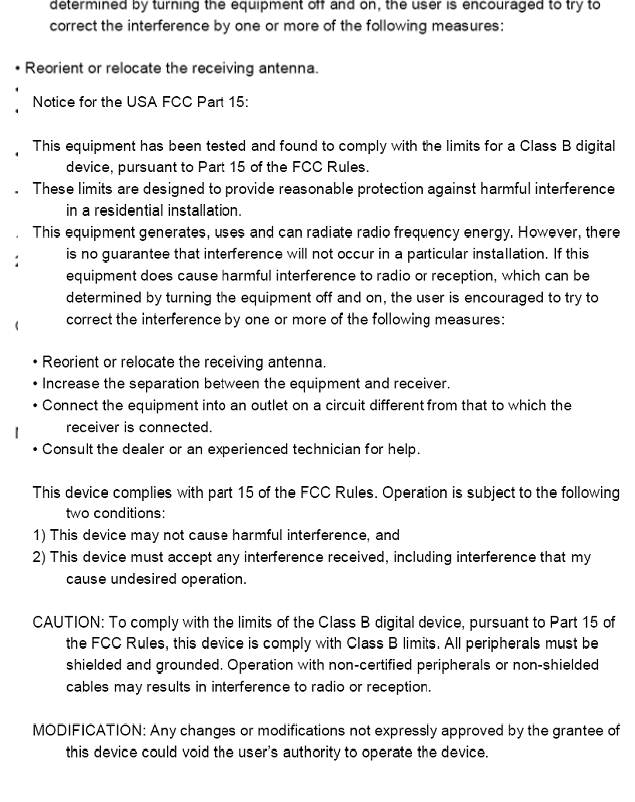
5
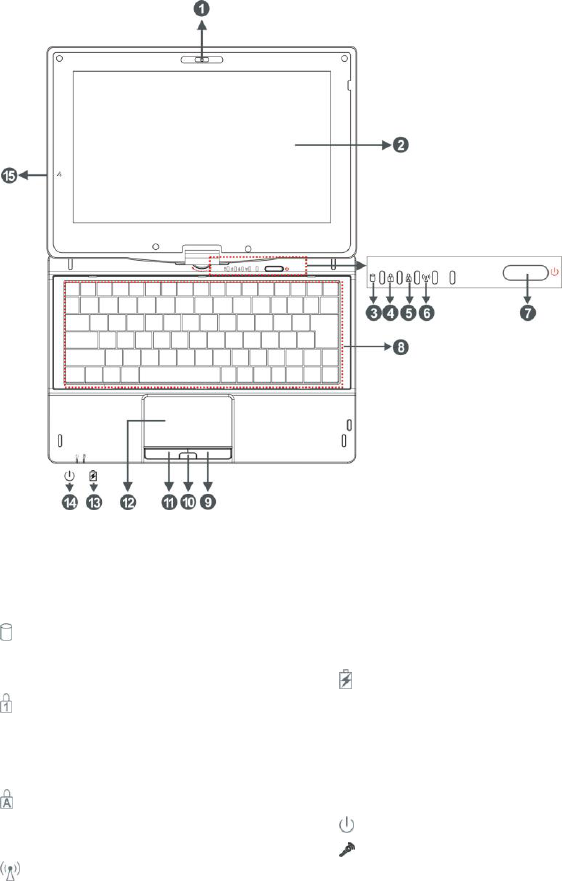
6
1 Knowing Your Notebook PC
1-1 Top Side
1. Built-in Camera
Click Fn+F1 to turn on or off the
camera function.
2. LCD Touch-senstive Screen
3. HDD Status Indicator
Light is green when the HDD is in
active mode.
4. Numeric Keypad Indicator
Click Fn+NumLk to turn on the light
and the numeric keypad is
unlocked.
5. Cap Lock Indicator
Light is green when the cap keypad
is unlocked.
6. WiFi Indicator
7. Power button
8. Keyboard
9. Right-key
10. One key lock button
11. Left-key
12. Touch Pad
13. Charge Indicator
Light is orange during being
charged and is green when the
battery is fully charged or
discharged; light flashes when the
battery is weak.
14. Power Indicator
15. Microphone
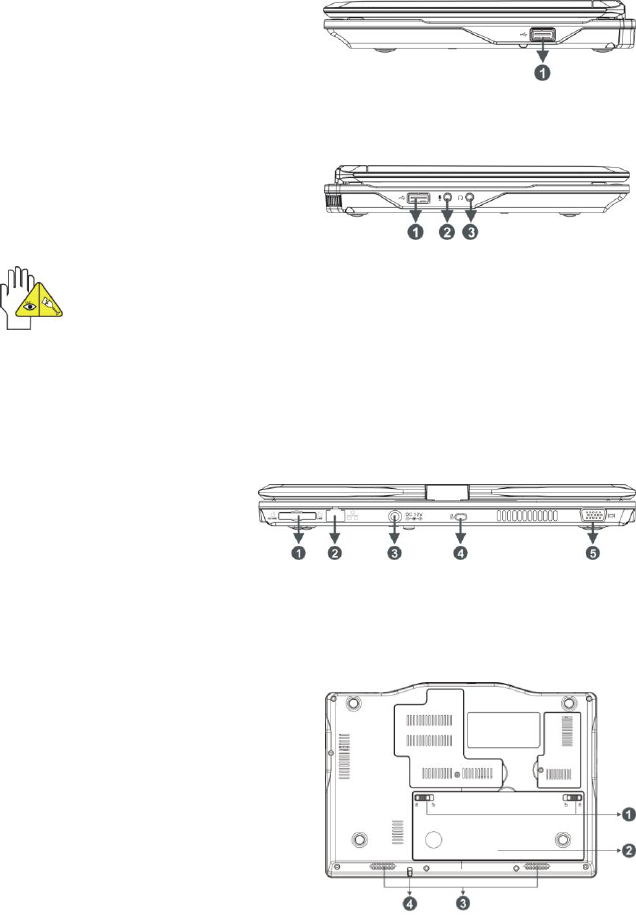
7
1-2 Right Side
1. USB Port (2.0)
1-3 Left Side
1. USB Port (2.0)
2. Microphone Jack
3. Headphone Jack
The USB card can only be inserted in one orientation. Force to insert the card
may in result of damage.
1-4 Rear Side
1. SD/MMC/MS Port
2. Ethernet/LAN Port
3. Power Jack
4. Lock Port
5. VGA Port
1-5 Bottom Side
1. Battery Latch
2. Lithium Rechargeable Battery
3. Speakers
4. Touch pen slot

8
2 Caring the Notebook PC
The Notebook PC is a precision device; the error operation may damage the device.
2-1 LCD Screen
LCD Screen is the most delicate component of the Notebook PC and comprised of
thin glass. It may be broken up by external abrupt force. DO NOT scratch the cover of
the Notebook PC, or the scrape on the cover cannot remove.
DO NOT cover the LCD Screen strongly, or else damage may occur.
DO NOT place objects on the keyboard to avoid damaging the screen and
keyboard when you cover the LCD Screen.
Place the Notebook PC in carrying case to protect it from dirt, water, shock and
scratches before traveling.
DO NOT drop or place heavy objects on the LCD Screen.
DO NOT scratch the LCD Screen with your fingernails or any hard objects.
Use a soft and lint-free cloth to wipe your Notebook PC and wipe it gently in order to
avoid damaging the LCD Screen.
Shut down the LCD Screen, if the Notebook PC will not be used for a long time.
DO NOT clean the LCD Screen with chemical cleaners.
The LCD Screen DOES NOT come into contact with hard objects (E.g.: cloth button,
watchband).
Use a soft and lint-free dry cloth to wipe the LCD Screen smoothly. DO NOT use
your hand to wipe the LCD Screen directly.
DO NOT spill liquid into the Notebook PC as it can damage the components of the
Notebook PC.
Cover the LCD Screen smoothly in order to avoid moving the hinges and flashing
the LCD Screen.
DO NOT clean the Touch Pad with acidic cleaner or spray cleaning solution
directly on the Notebook PC.
2-2 Hard Disk Drive (HDD)
Place the operating Notebook PC in steady and even table. Poor handling of the
Notebook PC may damage the HDD.
The HDD is the most delicate component in turning on and powering off the
system. The HDD operates at unsteady fast speeds during turning on the
Notebook PC; the vibrancy may damage the track of HDD. If the axes of the HDD
have not stop completely at the powering off the Notebook PC, the vibrancy may
damage the HDD.
9
2-3 Battery Pack
Please recycle the Battery Pack, and check with your Local Authority or retailer for
recycling advice.
DO NOT put the Battery Pack near or into the fire, or else it may cause fire or
explode.
The Battery Pack will short circuit if the Battery Pack is punctured or reassembled
The ideal temperature range that the Battery Pack be used is between 20℃-30℃.
Any temperatures above or below this range will shorten the life of the Battery Pack.
2-4 Keyboard
Keyboard is the most often used component by finger directly. Use a little brush to
clean or a can of compressed air to remove dust from between the keys on the keyboard.
Moisten a soft, lint-free cloth with water or cleaner and wipe the surface of the keys
smoothly.
If the water seeps into the keyboard, the circuit will not be damaged directly because
of the no-power supply keyboard. But the deteriorate of the Printed circuit board will
occur and will result in malfunction of the keyboard. Contact your dealer for advises at
this moment.
2-5 Touch Pad
Keep your hand clean when using the Touch Pad, or else the cursor is out of
control.
If the Touch Pad is dirty, moisten a soft, lint-free cloth with water and wipe the
Touch Pad smoothly.
The Touch Pad is pressure sensitive, DO NOT scratch the Touch Pad with hard
objects, or rest heavy objects on it.
2-6 Other accessories
Following the below steps before cleaning your Notebook PC and the accessories.
1. Turn off the Notebook PC. Disconnect your Notebook PC and all external devices
from their electrical outlets and remove the installed battery.
2. Use the little dust collector to pump the dust from the slot of plug or keyboard.
3. Moisten a soft, lint-free cloth with water and wipe the surface of the Notebook PC
smoothly. DO NOT seep liquid into the Notebook PC in order to avoid shorting of
circuit and the damage of the Notebook PC.
4. Turn on the Notebook PC after drying it.
10
2-7 If the water comes into the Notebook PC
DO NOT turn on the Notebook PC immediately.
Disconnect the outlet cable and detach the Battery Pack in order to turn off the
Notebook PC, instead of pressing the POWER button to turn off it. Disconnect all
external devices.
Spill out the water from the Notebook PC. Use a soft and waterish paper or cloth to
wipe the surface of the Notebook PC lightly.
Use the fanner to dry the Notebook PC and the accessories, and then send it to
the service center for advice.
DO NOT use hair drier to dry the Notebook PC, or the high temperature may distort
it.
DO NOT place the Notebook PC into the dirty carrying case again.
2-8 Other Notes
DO NOT expose the Notebook PC in hot environment for a long time, especially in
the car. Or the parts of the Notebook PC will be metamorphic.
Keep the data for future possible use termly.
Renew the hardware or software termly in order to keep the Notebook PC
compatible and steady.

11
3 Traveling with the Notebook PC
Turn off the Notebook PC and disconnect all lines before moving it. Following the
below steps, if you want to travel with your Notebook PC.
3-1 Attention
1. Charge the Battery Pack and the spare Battery Pack fully.
2. Turn off the Notebook PC and disconnect from the wall outlets.
3. Shut down the LCD Screen completely and smoothly.
4. Disconnect the AC lines.
5. Disconnect all lines.
6. Place the Notebook PC in carrying case to protect it from dirt, water, shock and
scratches before traveling.
7. Check that you have taken the spare Battery Pack, AC Adapter, power lines,
manual and warranty card. DO NOT forget the passwords of the Notebook PC and
HDD.
8. Find out the voltage type in the countries you will visit. Your Notebook PC comes
with a universal AC-DC adapter, so you only need to buy the different power cords
to connect the different outlets or the hotel may provide universal outlets to support
your power cord as well as voltages.
If you drive your car with the Notebook PC, DO NOT leave the Notebook PC
facing the sun. Place it in the shady and cool area.
DO NOT remove the HDD immediately while or after operating. Set the
Notebook PC into the Standby mode or Hibernation mode, before moving it.
The connection between Internet and your Notebook PC will be interrupted
when the system enter the hibernation mode.
3-2 How to enter the suspend mode
Click the left button of the mouse on the “Start”→ Click the left button of the mouse
on the “POWER OFF”,Click the left button of the mouse on ”Standby” or ”Hibernation”
items,then the system will enter the standby mode or Hibernate mode.
If you will attend a meeting with the Netbook PC and want still keep the Netbook PC
in the current state, please set the system into suspend mode. When you turn on the
Netbook PC again, the system will return the last state, which you want.

12
4 Keep the data for future possible use
Your computer has been fully tested and complies with the system specifications
before shipping. However, incorrect operations, mishandling or any other reasons may
loss your data, e.g.: Delete or cover the data by error, Damage the HDD by vibration,
Damaged by Network virus, Disaster, Loss the data because of being stolen.
4-1 HDD Partition
The damage of the HDD or the operating system may be result in the loss of the
data in the HDD.
So you need to save your data to another memory card to avoid losing the data.
In order to improve the performance of your Netbook PC, the HDD of your Netbook
PC can be formatted with some partitions, C, D and so on. Save files to the any partitions
except C partition. Then you can retrieval or reinstall the operating system without
damaging your data.
Select the available software to part the HDD, as you like.
4-2 Class the data in the HDD
1) Files: Office files,Pictures,Music and so on.
2) E-mail: Sent mail, Address List and so on.
3) Information of Website: The favorite of Explorer,Bookmarks of Net-scape and
so on.
Save these data to the same file, or else you may forget copying some files to
the spare HDD or the other memory card. Please save your data for future
possible use termly.
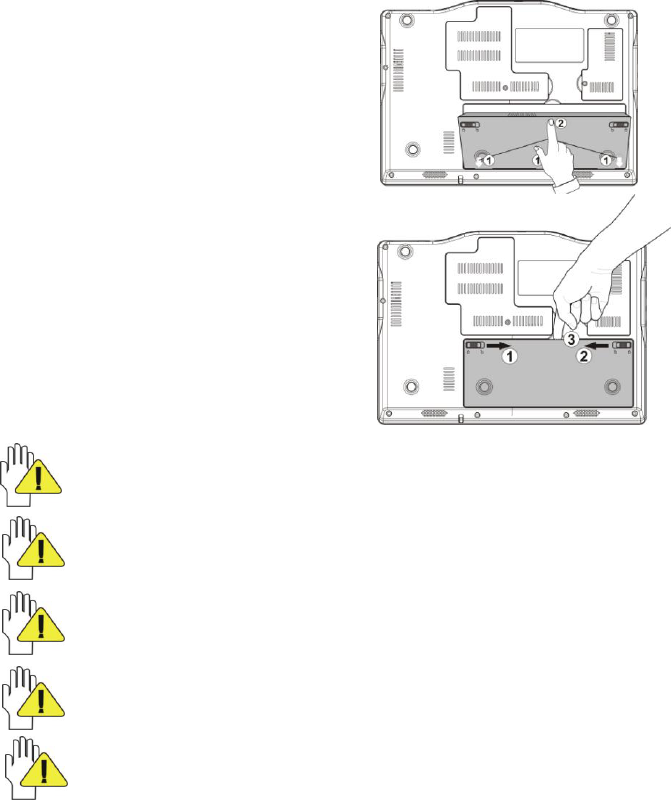
13
5 Getting Started
5-1 Install the Rechargeable Battery
Power the Notebook PC before using it. There are two ways to power the Notebook
PC: Use the AC Adapter to power it or use the removable Battery Pack.
The Notebook PC is designed to work with a removable Battery Pack. Your
Notebook PC may or may not have its Battery Pack installed. If your Notebook PC does
not have its Battery Pack installed, using the following procedures to install the Battery
Pack:
Place the Battery Pack into the card-slots of
the Notebook PC toward the arrow ①and then
press it toward the arrow ② to Battery Pack.
5-2 Remove the Battery Pack
1. Turn off the Notebook PC,and disconnect
all lines.
2. Shut down and turn over the computer to
access its base in flat and clean work
surface.
3. Slide the Battery Latch toward the arrow
① and slide the Battery Latch toward the
arrow ②.
4. Pull the Battery Pack out from the
Notebook PC toward ③.
While you don’t use the WIFI network, press <Fn>+<F2> to turn off and it can
increase the usage time of the Battery Pack.
WARNING! For safety reasons, DO NOT disassemble the Battery Pack, DO
NOT short the circuit, DO NOT throw the Battery Pack into fire and keep it
away from children.
When the Notebook PC with Battery Pack (disconnect the adapter) turns on,
the Power Indicator will turn on. And the light will turn off when in standby
mode or system halting.
DO NOT attempt to remove the Battery Pack while the Notebook PC turns on,
as this may result in the loss of working data.
Damage may occur if you use a different adapter to power the Notebook PC or
use the Notebook PC’s adapter to power other electrical devices.
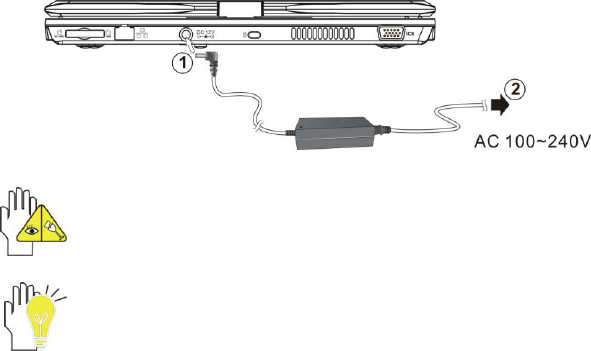
14
5-3 Connecting the Power Adapter
The Notebook PC comes with a universal AC-DC adapter and the allowable input
voltage of adapter is from 100V to 240V.
Following the below steps to connect the adapter:
1. Take the adapter and the power cord, and then connect the adapter with the power
cord.
2. Plug the DC end of adapter into the power jack of the Notebook PC.
3. Insert the AC end to the wall outlet
4. Check the connections above correctly before turning on the Notebook PC.
DO NOT remove the Notebook PC if the HDD is being read or written, that
may result in the loss of the data and the damage of the disk. Follow the
system steps to turn off the Notebook PC.
Your Notebook PC and the accessories may differ from the pictures
shown.
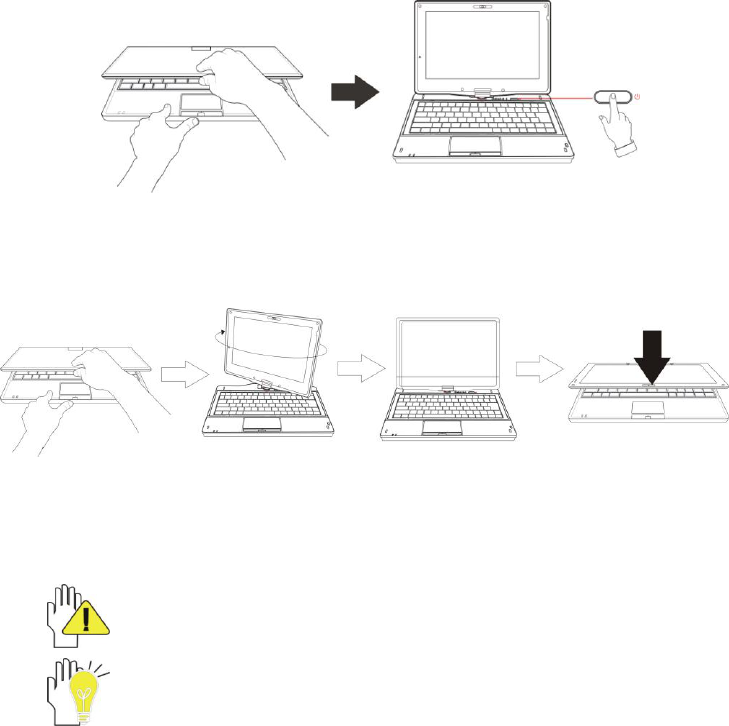
15
6 Using Your Notebook PC
6-1 Turning on the Notebook PC
1. Open the LCD screen and adjust the angle of the Notebook PC’s LCD Screen
2. Press the POWER button to turn on the Notebook PC.
6-2 Revolving LCD screen
The revolving LCD screen is one of the outstanding features of the unit. We’d like to
suggest you to take the following steps for proper operation.
1. Open the screen.
2. Revolving the screen horizontally as its axis in the clockwise only.
3. The maximum revolving degree is 180.
4. Then cover the screen to the keyboard.
Please ratate the screen softly according to the indicated angle in the above
illustration to avoid the damage of the LCD Screen.
Recommend to turn on “One key locking” button to lock the touchpad while
rotating the screen to the keyboard.
6-3 Adjust the Brightness of LCD Screen
The Notebook PC uses an active matrix TFT LCD and provides a Display (Monitor)
Output Port to connect the external monitor. The Notebook PC supports the function to
adjust the LCD Screen through the following composite buttons.
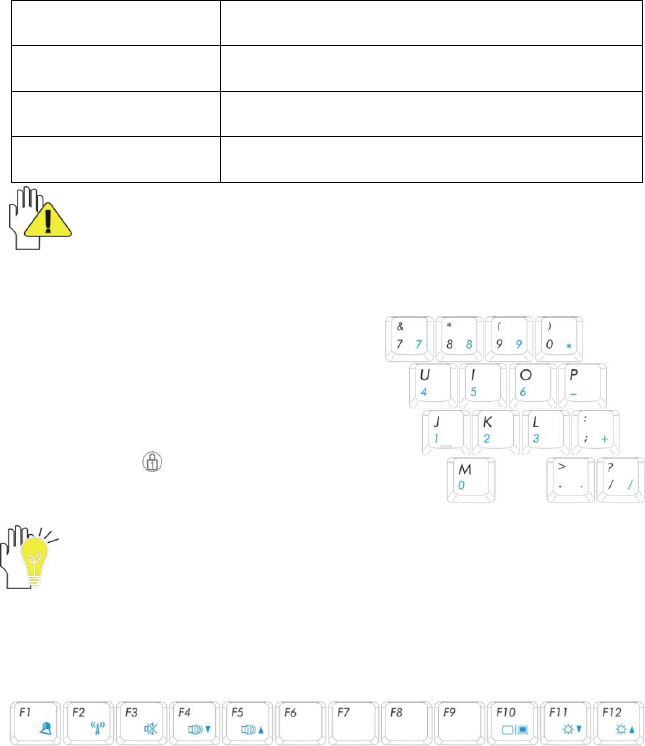
16
Click
Function
<Fn>+<F10>
Shift between LCD Screen and external monitor
<Fn>+<F11>
Decrease the brightness of screen
<Fn>+<F12>
Increase the brightness of screen
LCD Screen is made of glass and may be damaged if the Notebook PC is
dropped or shoves any hard object.
6-4 Keyboard Usage
The Notebook PC’s integrated the
keyboard with 82 keys.
Click the numeric/symbol keys to input
the desired keys after starting the
keyboard.
Press <Fn+NumLk> key to enable the
keypad, the light indicates that the
keypad is active; press < Fn+NumLk>
key again to disable the keypad.
Each key on the keyboard may have multiple functions in different software.
Function Keys
These function keys with the color word or icon sign means that their function only
can be activated when clicking the function key and the <Fn> key at the same time.
<Fn>+<F1>:Turn on or turn off the camera window.
<Fn>+<F2>:Turn on or turn off the WiFi.
<Fn>+<F3>:Turn on or turn off the mute.
<Fn>+<F4>:Turn down the volume.
<Fn>+<F5>:Turn up the volume.
<Fn>+<F10>:Shift between LCD Screen and external monitor.
<Fn>+<F11>:Decrease brightness of LCD Screen.
<Fn>+<F12>:Increase brightness of LCD Screen.
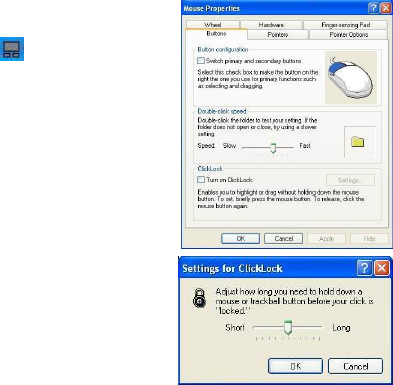
17
6-5 Touch Pad(Optional, under Windows XP)
The Notebook PC supports the software “Finger-sensing Pad”. If the product you
purchased has preinstalled the software, please refer to the following detailed operation:
6-5-1 One key locking button
You can press the “one key lock button” at the bottom corner on the touch pad to
activate or disable the function of touch pad.
6-5-2 ClickLock Function
Move the cursor to the icon at the
right-bottom corner of the desktop and right click the
mouse, then select “Settings” to enter the menu
“Mouse Properties” as shown right:
On the menu, click to tick the panel in front of
“Turn on ClickLock” and then click “Setting” to enter
the label “Setting for ClickLock” that you can click to
adjust the respond time to lock as shown right.
Click “OK” to return to menu “Mouse Properties” after adjustment, then click
“Apply”—“OK” to activate the clicklock function.
Since the function is activated, the mouse would be locked in the desired time and
the folder would remove as the cursor; click the right button of the mouse again to place
it on the new desired position, that enables you to highlight or drag without holding down
the mouse button.
6-5-3 Multi-Finger Gesture
The software “Finger-sensing Pad” provides intuitive multi-finger gestures, which can be
applied to customized functions, like Zoom In/Out, Scrolling, etc. See as below:
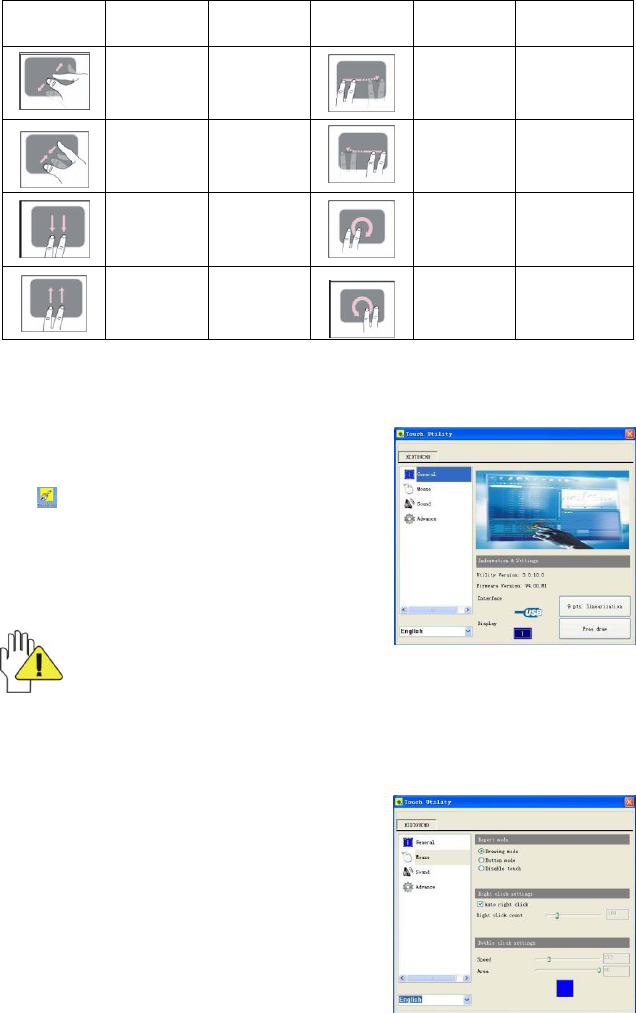
18
Illustration
Gesture
Function
Illustration
Gesture
Function
Expand
Zoom Out
Object
Flick Right
Forward
Narrow
Zoom In
Object
Flick Left
Backward
Scroll
Down
Next Page
Rotate
Clockwise
Object
Scroll Up
Previous
Page
Rotate
Anticlockwise
Object
6-6 Touch tool
The Notebook PC utilizes a user-friendly touch-sensitive screen.
Touch Utility
After turning on the Notebook PC, double click the
icon “Touch Tool” on the desktop to enter the
right menu.
You can set the desired screen language by
clicking the down arrow at the left-bottom corner.
The selected screen language should be supported by the system.
6-6-1 General
This option is used to see the related information about the current touch tool, then you
can have a test to calibrate the touch screen and draw free as well.
6-6-2 Mouse
Within this menu, you can activate the touch
reaction and setting the touch mode.

19
Report mode
Drawing mode: to click, draw or box clicking and etc by the finger or touch pen on the
screen as the mouse button.
Button mode: to operate by the finger or touch pen on the screen as same as the left
button of mouse.
Disable touch: to cancel the touch.
If you can’t operate the touch screen, please check whether the option
“Disable touch” is selected.
Right click settings
This option is only available when “Drawing mode” is seleced under Report
mode.
If you need to operate by clicking the right button, please select and click the target
object firstly, then click and tick the option “”Auto right click” to operate by the right
clicking; you can also set the count for right click by dragging the cursor behind the
option “Right click count” and keep the cursor on the target object to pop up the function
menu in the desired time.
Double click settings
Speed: to set the speed for double click.
Area: to set the area for double click that clicking should be in the same area, or it would
be unavailable for double click.
6-6-3 Sound
To set the desired sound source for pen down or pen up when touching by touch pen.
6-6-4 Advance
To know more about the touch tool.
6-7 Card Reader Usage
The Notebook PC has a single built-in memory card reader that can read the
following flash memory cards: Secure Digital, Multi-Media Card, Memory Stick. See the
manual of the relevant card for more information.
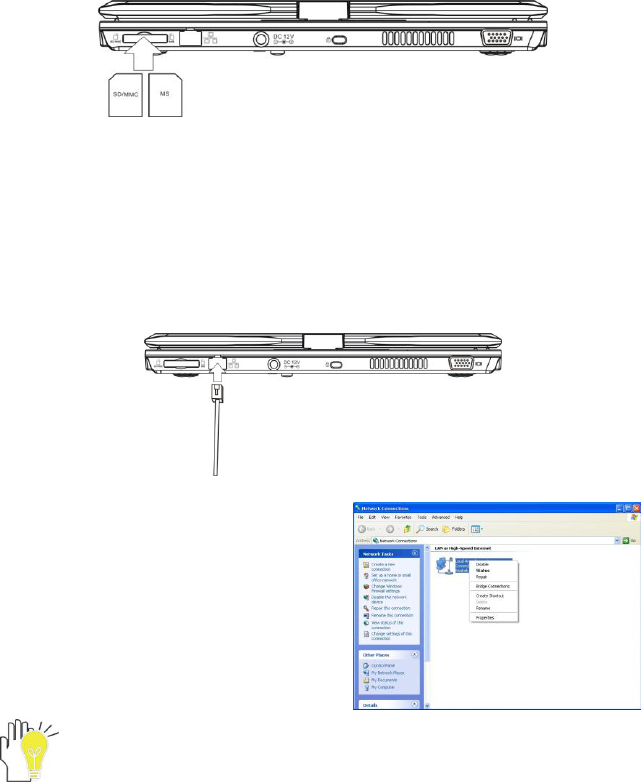
20
6-8 The Memory Card
Insert The Memory Card
The card only can be inserted in one orientation (with the card’s electrical contacts
towards the bottom of the unit). Force to insert the card may in result of damage.
Pull out the Memory Card
Stop the card’s operation, then pull the card out from the port.
7 Internet Connection
7-1 Connect the Lineate LAN
Before connecting the network with your computer, setup your network system first, and
then connect telecommunication line to your Notebook PC.
Setting the Network system
Click the right button of the mouse on the
“My Network Places”, click the left button of
the mouse on the “Properties” item to enter
the “Network Connections” windows, as
show right:
Contact your Internet service provider for more information about the setting of
IP and DNS.
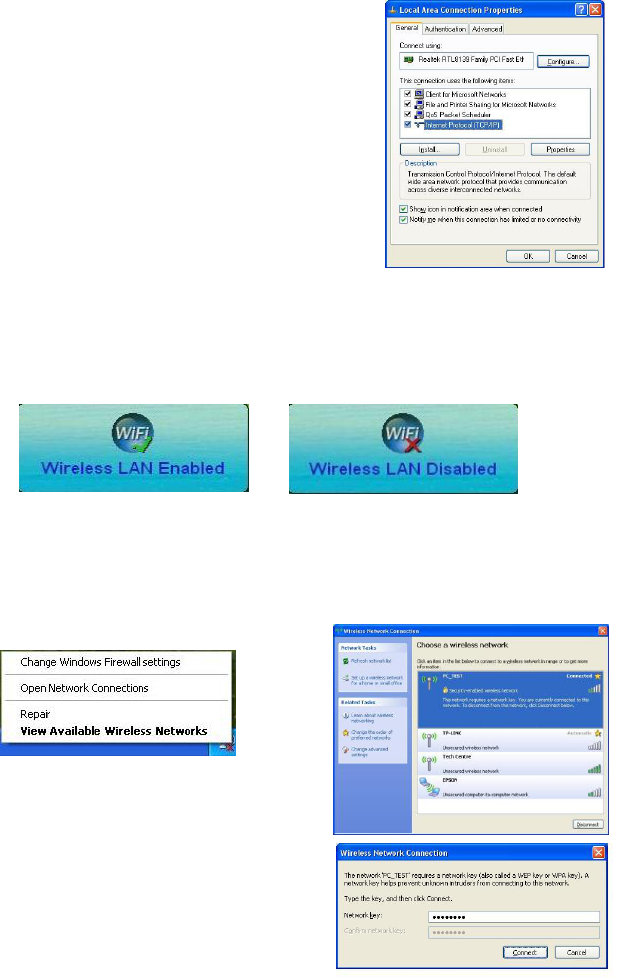
21
Click the right button of the mouse on the icon of
“Local Area Connections”, click left button of the
mouse on the “Properties” item to display the menu of
“Local Area Connection Properties”, as show right:
On the menu of “Local Area Connections Property”,
click the left button of the mouse on the “Internet
Protocol(TCP/IP)”→ click the left button of the mouse
on the “Properties” to enter the “Internet Protocol
(TCP/IP)Properties” windows.
Select the “General” label on the “Internet Protocol
(TCP/IP)Properties” windows, and enter the address
of your IP and DNS, or select “Obtain an IP address automatically”.
7-2 Wireless LAN
Click <Fn>+<F2> to turn the wireless network on or off. The screen will display as
following:
When the wireless network turns on, the WIFI Indicator turns green and the icon of
WIFI will display on the right-bottom of the desktop.
Click the right button of the mouse on the icon of WIFI, click the left button of the
mouse on the “View Available Wireless Networks” of the pop-up menu or click the left
button of the mouse doubly on the icon of WIFI to enter the windows of “Wireless
Network Connection”, as show below:
Click the left button of the mouse on the
“Refresh” of the windows, the system will
search and list the available wireless
Networks. The information of the Networks
will be displayed when you select the
relevant network. Some Networks may need
to type the password before connecting.
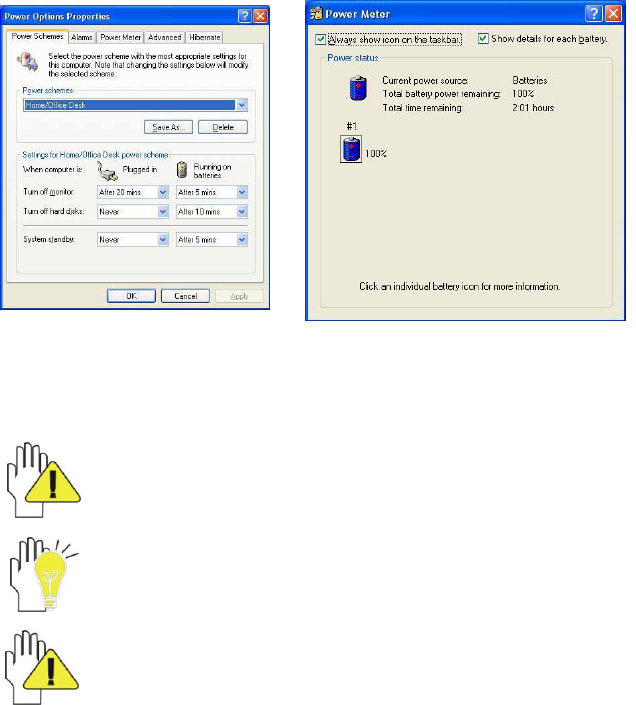
22
8 Power Managing System
8-1 Battery System
The Notebook PC is designed to work with a removable and high capability Battery
Pack.
8-1-1 Checking Battery Power
Click the left button of the mouse on “Start”→“Performance and Maintenance“, then
click “Power Options”, the menu will display as below. On the window, click the left
button of the mouse on “Power Meter” label to check the power of the battery.
Set the shortcut to check the remaining battery power: click the left button of the
mouse on “Advanced” label, select “ Always show icon on the taskbar”. Then move your
cursor over the power icon in the left-bottom of the desktop to see the battery power.
DO NOT attempt to remove the Battery Pack while the Notebook PC is
turned on, as this may result in loss of working data and damage of the
Notebook PC.
When you use your Notebook PC first time, check the remaining battery
power, and make sure that the new Battery Pack has been completely
charged.
The Battery Pack has limit on the number times it can be recharged. In any
case, the Battery Pack’s usage time will eventually decrease and a new
Battery Pack must be purchased from an authorized dealer for this
Notebook PC.

23
8-1-2 Charging the Battery Pack
When you use your Notebook PC first time, check the remaining battery power, and
make sure that the new Battery Pack has been completely charged before the Notebook
PC is disconnected from external power.
The Battery Pack begins to charge as soon as the Notebook PC is connected to the
external power, and the Charge Indicator light will turn on. When the Battery Pack
charges completely, the Charge Indicator light will turn off. Save your working data or
connect the adapter when the battery power is low. And the battery will stop charging if
the battery is fully charged.
8-1-3 Low Power Warning
The system will display the warning windows and advise you to connect the adapter,
when battery power is low. Save your working data if you don’t have the adapter at this
moment. The warning function can be set in the “Power Options” menu.
8-1-4 Battery Power
The Battery Pack’s actual figure varies will depend on how you use the power
saving features, your general work habits, the CPU, system memory size, and the size of
LCD Screen. Please turn on the manage power function and connect the adapter to save
electric power.
8-1-5 Store the Battery Pack
DO NOT leave the Battery Pack discharged; the Battery Pack will discharge over
time. But in any case, the Battery Pack’s usage time will eventually decrease and a new
Battery Pack must be purchased.
It is ideal that the battery be stored in a temperature range between 10℃ and 35℃.
Any temperatures above or below this range will shorten the life of the battery. If the
temperature is too high, it may cause fire or explode.
DO NOT throw the Notebook PC in municipal waste. Check local regulations
for disposal of electronic products.
8-1-6 Prolonging the Battery’s Life
Use the AC adapter wherever the AC wall outlet is available. Charge the battery
completely for using in your traveling.
The ideal working temperature is from 20℃ to 30℃. Any temperatures above or
below this range will shorten the actual usage time of the Battery Pack.
After charging the Battery Pack completely, keep the Battery Pack in the Notebook
PC. It will stop charging if the Battery Pack is fully charged and not be damaged.
24
DO NOT leave the Battery Pack discharged over three month, the Battery Pack will
be damaged, it must continue to be charge every three months, as well as the
spare Battery Pack.
Purchase an additional Battery Pack.
DO NOT often plug or pull the Adapter from the electric outlets, it is the best way to
prolong the Battery Pack’s life.
The life expectancy of the Battery Pack is approximately 300 recharges.
Store the Battery Pack in cool and dry place, the ideal temperature is from 10℃ to
30℃. The Battery Pack will discharge quickly in hot environment and the life of the
Battery Pack will be shortened.
DO NOT throw the Notebook PC in municipal waste. Check local regulations for
disposal of electronic products.
DO NOT put the Battery Pack near or in the fire, or else it may cause fire or
explode.
The Battery Pack will short circuit if the Battery Pack puncture or reassemble.
8-2 Power Management Modes
8-2-1 Standby mode of the System
The function of Standby mode: Store your current data and status in RAM, turn off the
external device, but the Power Indicator Light still turns on. If you press the POWER
button, the system will operate again.
8-2-2 Hibernate
In “Hibernate” mode: The current data and status are stored on HDD and the
Notebook PC turns off (the Power Indicator Light will turn off). Press the POWER
button to restarting the system.
Activate the “Hibernate” function: Click the left button of the mouse on the
“Hibernate” label of the“Power Options Properties”windows, select the “Enable
Hibernate”, then “System Hibernate” will display in“Power Options Properties”
windows.
8-2-3 Log Off
Click the left button of the mouse on “Start” → click the left button of the mouse on
“Turn Off Computer” → select “Standby” or “Hibernate” → Enter the standby mode or the
hibernate mode.
If the system is force to turn off because of using up the power in the standby mode.
Your current data and status will be stored on the HDD. The system will operate again
after changing a power-full battery or connecting the wall outlets.
When the power is used up, the Notebook PC will exit the standby mode and turn off.
Store your working data, before using up the power of the Battery Pack.

25
8-2-4 Restart the System
Press POWER button to exit the suspend mode and enter the current status. And
the “restart” function will reactivate all the operating programs.
Press and hold the POWER button for over 4 seconds to turn off the Notebook
PC if the system halts. Press and hold the POWER button for over 2 seconds
to turn off in normal mode.
8-3 Power Saving
When you use a battery as the source power for your Notebook PC, you can take
advantage of power management settings to conserve battery life.
8-3-1 Connect the Adapter without using Battery Pack
The Battery Pack has a limit on the number times it can be recharged. DO NOT use
the Battery Pack if you have the adapter.
8-3-2 Adjust the brightness of LCD Screen
If necessary, adjust the brightness of the LCD Screen in order to save the electric
power. Close the LCD Screen if you don’t need to use your computer for a brief period.
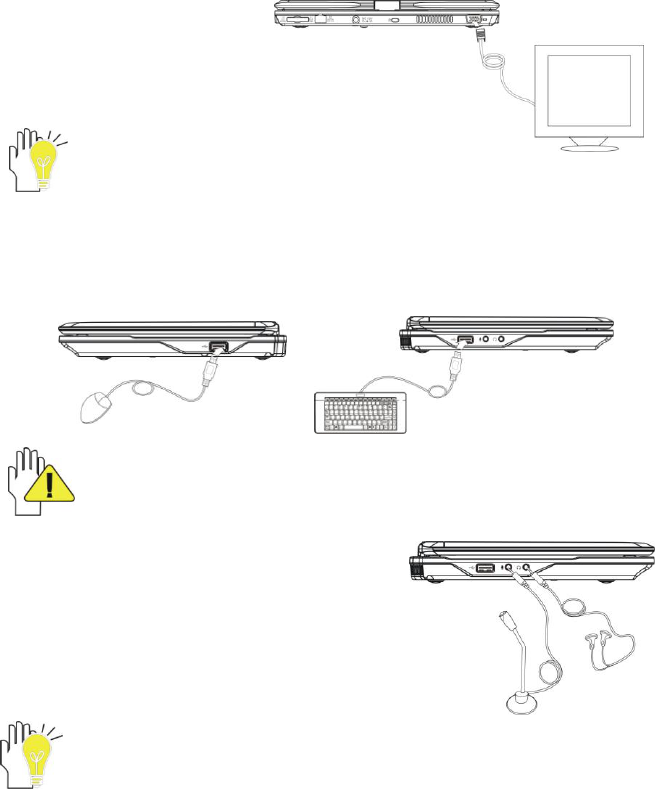
26
9 Upgrading Your Notebook PC
9-1 Connect the External Monitor
The Notebook PC supplies a VGA port for connecting External Monitor or projective
device.
9-1-1 How to connect the External Monitor
1. Turn off the Notebook PC
and insert the 15-pin D-sub
monitor plug to the external
monitor.
2. Turn on the Notebook PC.
<Fn>+<F10>:Shift between LCD Screen and external monitor.
9-1-2 Connect Keyboard and Mouse
The Notebook PC’s integrated the keyboard with 82 keys. If you want to use the
external keyboard or mouse, connect the external keyboard and external mouse by the
USB port.
When you disconnect the external keyboard or external mouse from the
computer, grasp the connector, not the cable itself, and pull firmly but
gently to avoid damaging the cable.
9-1-3 Connect Audio Device
The Notebook PC can be connected
headphone, sound box and microphone.
The speaker will turn off automatically after connecting the external
headphone to the Notebook PC. Excessively loud volume could damage your
hearing. So turn down the volume before connecting earphone, and then raise
the volume to comfortable level.
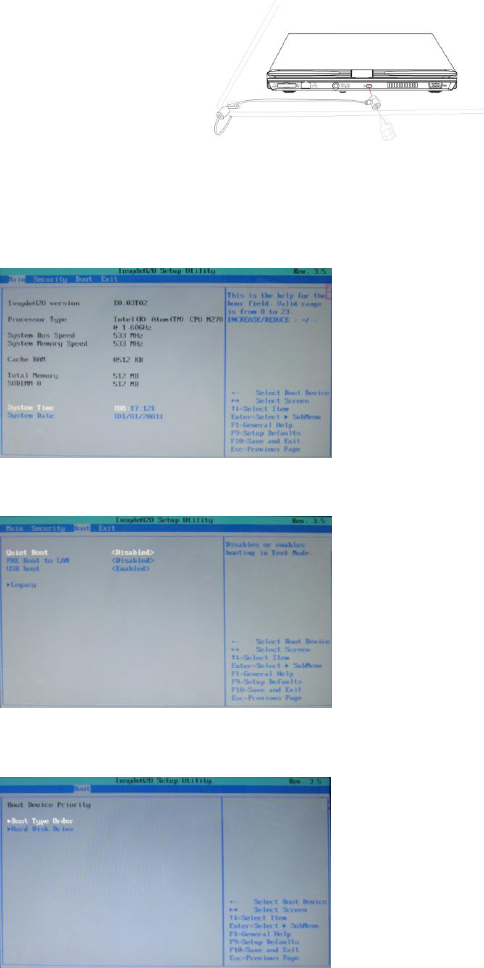
27
9-1-4 Lock Port
The Lock Port allows the Notebook PC to
be secured using and can prevent the
Notebook PC to be removed from a fixed
object.
9-2 Enter the BIOS Setup Menu
Follow the below steps to enter the BIOS Setup Menu:
1. Click F2 button quickly during loading the system, then the system will enter “Setup
Utility” as shown below:
2. Click the left/ right direction keys to select “Boot” and click the Enter button to enter
the below menu:
On the menu, click the up/down direction keys to select “Legacy” and click the Enter
button to enter the below menu:
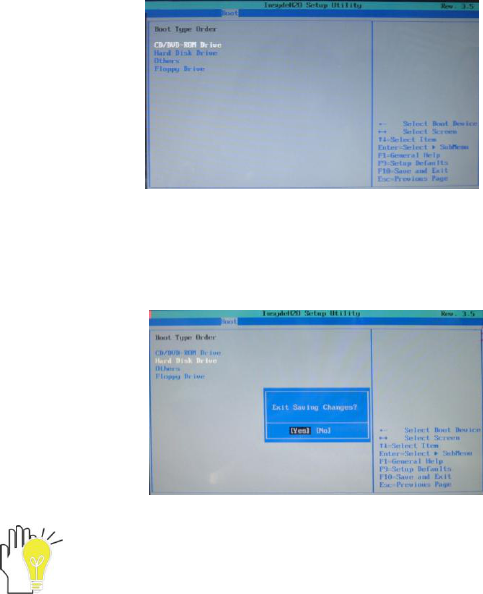
28
3. Click the up/down direction keys to select “Boot Type Order” and click the Enter
button to enter the below menu:
4. Click the “Shift” + ”+”or click ”-“ directly to remove the option position and then click
the up/down direction button to select the startup option. Proceed to click F10 to
popup the dialogue box and select “Yes” firstly, then click the Enter button to save
the setting as shown below:
There is no need to change the startup order and click F12 directly to select
the temporary startup option after turning on the unit.
29
10 Appendix
10-1 Troubleshooting
Q1:How to turn off the Notebook PC when the halted system cannot warm boot?
A:Press the POWER button and hold 4 or 6 seconds to turn off the Notebook PC.
Q2:How to check the Notebook PC if the Notebook PC cannot be turned off?
A:1.If the power is low, connect to the electric outlets.
2.Check that the video display system is not in the external monitor mode.
3.Make sure the indicator of the adapter turns on and the adapter works well.
4. Remove the U disk, SD card and any other external device.
Q3:If the water come into the Notebook PC
A:1. DO NOT turn on the Notebook PC.
2. Disconnect the outlet cable and detach the Battery Pack in order to turn off the
Notebook PC, instead of pressing the POWER button to turn off it. Disconnect all
external devices.
3. Spill out the water from the Notebook PC. Use a soft and waterish paper or cloth
to wipe the surface of the Notebook PC lightly.
4. Use the fanner to dry the Notebook PC and the accessories, and then send to the
service center for advice.
5. DO NOT place the Notebook PC into the dirty carrying case to again.
Q4:After entering the standby mode, why the system cannot reactivate and how to
check this problem?
A:Definition:
Standby Mode:Store your current data and status in RAM, turn off the external
device, but the Power Indicator Light still turns on. Press POWER button to operate
the system again.
Suspend Mode:The computer saves the current state of the system in RAM and
switches off power to the CPU. The power indicator light flashes in this mode.
Press the POWER button to restart the system.
Q5:Why the system cannot be recover?
A:1.Damage from External memory or built-in memory: If the data are saved to an error
memory address, the data cannot restore.
2. Incompatible external device: The system may enter the standby mode and
cannot resume, when the incompatible external device is connected to the Notebook
PC.
3.Error from drive program or application program: The system may refuse to
operate some files (file formats: .dll, .sys, .exe and so on.) and enter the standby
mode or hibernate mode. If the incompatible application program will be refused by
the operating system, the system may fail to recover.
Q6:How to check the system which cannot recover?
A:1.Remove the external devices and their device program.
30
2.Refresh BIOS system
3.Refresh the appropriate program.
4.Remove the error application program.
5.Reinstall the operating system.
6.Send back the Notebook PC for checking.
Q7:How to prolong the life of the Battery Pack?
A:1. Adjust the brightness of the LCD Screen to proper level.
2. Turn down the volume.
3. Make the appropriate setting in the Power Management menu.
Q8: If the image isn’t clear
A: Check that the lens is clear or not, if not, clean with the soft cloth.
Q9: If the mobile moves slowly
A: The camera needs some light when gathering the data and the speed will be slow if
the light condition isn’t good. Please adjust the screen position of the Notebook PC or the
position of the user.
The image display also shall be slower by the heavy loading for the system when
the many applications are running. Please close the unused procedure.
Note:
Q8 and Q9 are the questions when you are using the camera for video capture,
conferencing, and chatting.
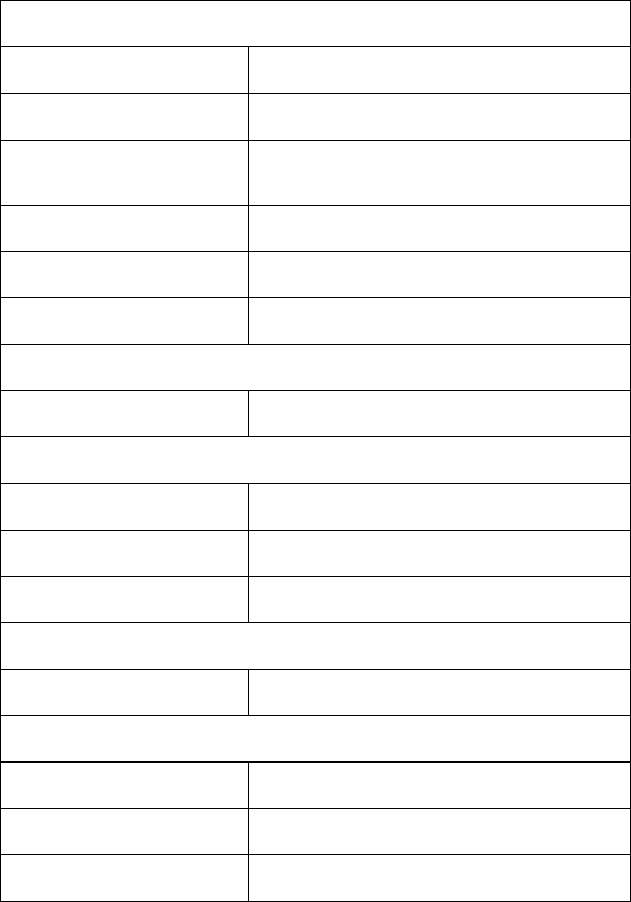
31
10-2 Specifications
Main Feature
CPU
Intel Atom N270(1.6GHz, 533MHz FSB)
CPU Power Consumption
2.5W MAX
L1 Cache Size
On-die, primary 32-kB instructions cache and
24-kB, write-back data cache
L2 Cache Size
512-kB on-die second level cache
Memory (#)
Max 2GB
Memory Type
DDRII 533/667 MHz
Storage
HDD Capacities (#)
Max 320GB
TFT Screen
TFT Screen Size
10” inch touch-sensitive
Screen Type
TFT
Description
TFT LCD 1024X600 (WSVGA)
Built-in Camera
Resolution
0.3M Pixels
Video/Audio Feature
Video Card Type
Intel GMA 950
Video Card Capacity
Share Dynamic EMS Memory 128MB(Max)
Audio System
Built-in speaker
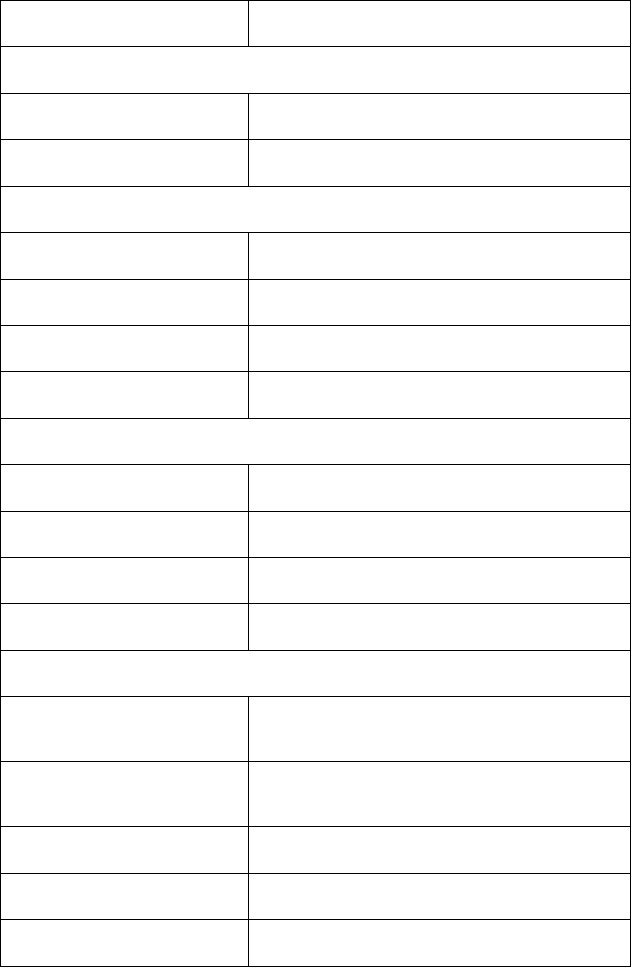
32
Sound Card Type
HD Codec
I/O Device
Mouse
Touch Pad
Keyboard
82-key keyboard
Condition
Operating Temperature
5-35℃
Operating Humidity
35%-85%
Storage Temperature
-20-55℃
Storage Humidity
20%-93%
Power
Adapter
AC 100~240V; DC 12V
Output Power (maximum)
≤36W
Battery (Type)
Lithium rechargeable battery
Voltage
7.4V
Port Standard
LAN
LAN Type: 10/100Base-T
Wireless Card: 802.11 b/g/n
Audio Port
Headphone Port, Speaker, Built-in Microphone,
Microphone Port
USB Port
USB-A Port(x2),USB2.0
SD Card Port
Support SD/MMC/MS Card
VGA Port
D-15 Output
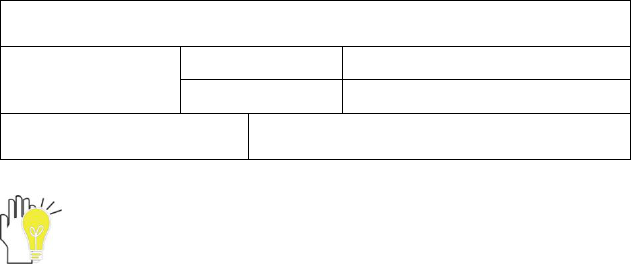
33
Physical Features
Weight
No battery
About 1.15Kg
With battery
About 1.35Kg
Dimension
265mmx 190mm x29mm
Design and specifications are subject to change without notice. The # symbol
means that the item is optional.